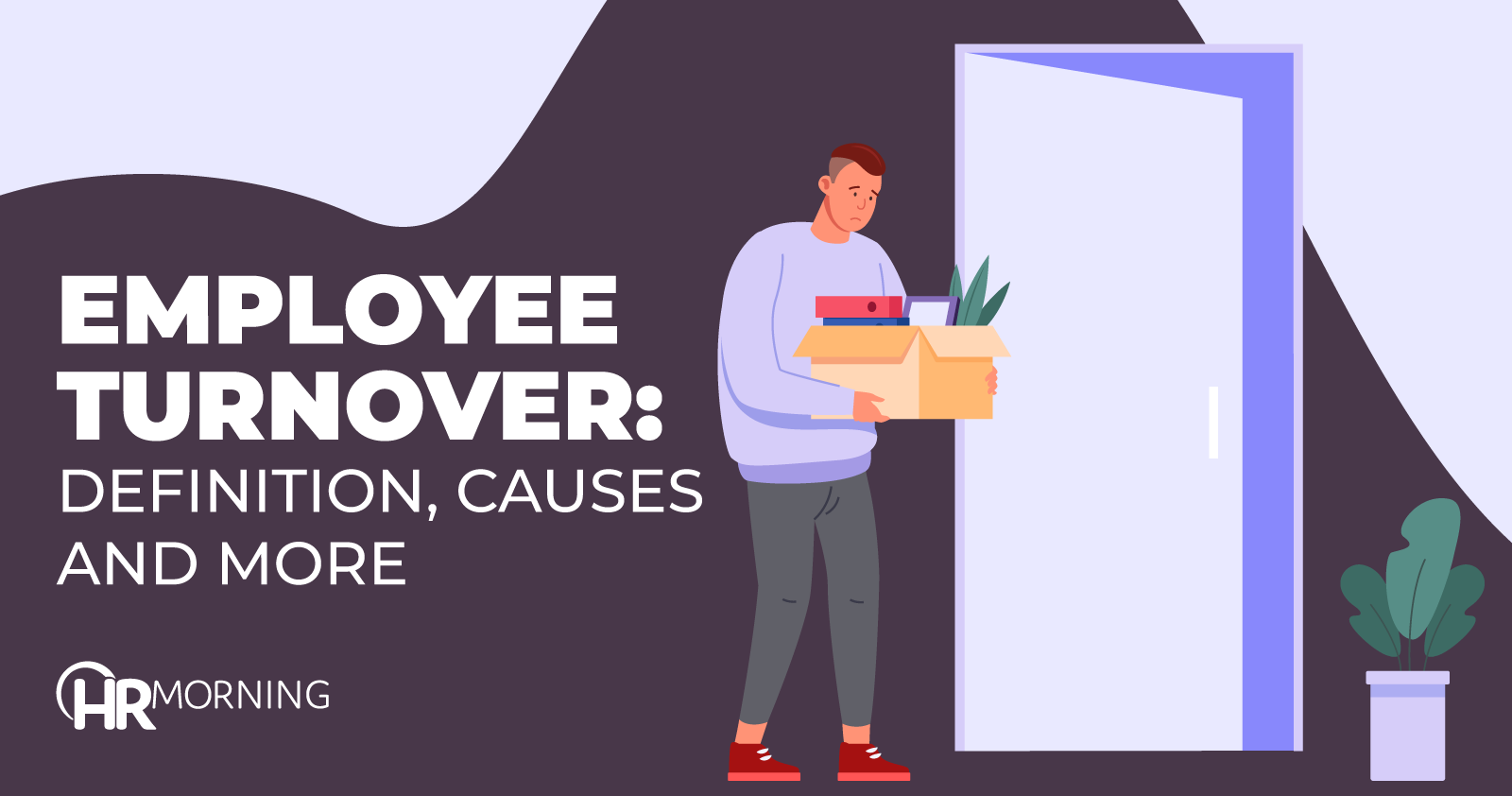Employee turnover is a fact of life. It’s also something human resource teams must focus on to increase retention. To combat it effectively, the right people need to get involved.
If hiring managers don’t take control over employee turnover and morale, they may be jeopardizing their organization’s future. High turnover is not a problem that can be solved easily. Employers have to dig deep to find out why employees are leaving. This guide will help you manage turnover by understanding exactly what it is – and what causes it.
What is employee turnover?
Employee turnover is defined as the percentage of employees that leave your organization during a given period.
Essentially, turnover occurs when employees are separated from employment, either voluntarily or involuntarily.
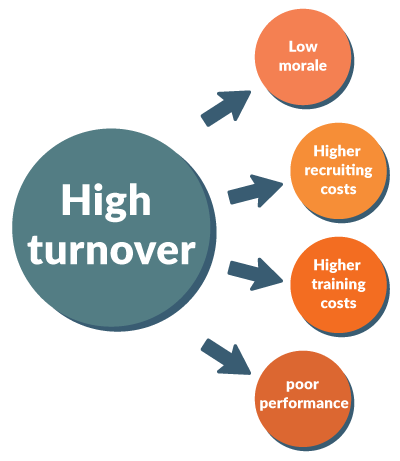
When one worker is replaced with another, that is turnover. Employee turnover is often estimated by the annual turnover rate (ATR), which is defined as the percentage of employees leaving employment in a given year. It can also be calculated by month or quarter.
High turnover may result in lower morale among remaining staff, higher recruiting and training costs, and poor performance. By reducing high turnover, employers can up their game and get the most out of their workforces.
Turnover is a costly affair for any business, and it is ill-affordable in this economy.
Types of turnover
There are two types of employee turnover: voluntary and involuntary. Both types are determined based on how the employee departs from a company or department; that is, whether they chose to leave or if that decision was made for them.
Voluntary Turnover
Voluntary turnover happens when employees leave their positions for other opportunities both within their organization or outside it. Voluntary employee turnover can be beneficial for employee-employer relations.
It shows that the employee is satisfied with their position and is taking advantage of other opportunities within or outside the company. It shows that the worker was satisfied enough to communicate their next career moves effectively with their current manager.
Suppose a worker gets a promotion within the company but in a different department. That would count as turnover in that specific department, but it’s not a negative for the company. Still, hiring managers still have the job of looking into why people leave particular departments.
The voluntary turnover rate measures the percentage of employees who voluntarily leave their jobs during a specified period. It’s typically calculated as the number of employees who resigned during that time divided by the average number of employees for that same period.
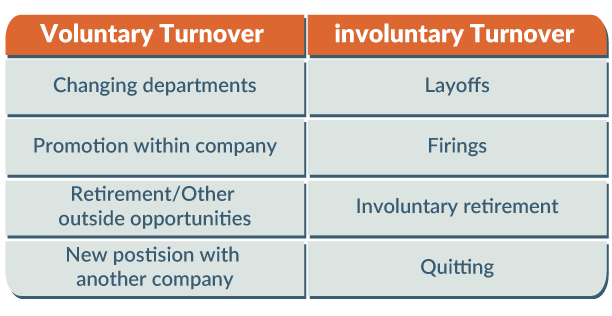
Involuntary turnover
Involuntary turnover happens when employees are fired, laid off, quit, or retire involuntarily. This type of employee turnover can hurt employee morale, and it may also convince other workers to leave.
When employees get fired, it’s usually because of poor performance or job-related misconduct. Layoffs, on the other hand, usually are a result of economic circumstances that lead to things like department closures and general downsizing.
Voluntary and involuntary employee turnover both play a role in understanding the factors that drive employees to leave their positions. Both types happen due to a lack of workforce engagement and poor employee selection processes.
Voluntary attrition has increased over the past 20 years, while involuntary attrition has declined. The message is clear: Employees do not feel compelled to stay in a position that is not meeting their needs. Workers can perform their job duties and choose when they leave without causing problems in the workplace.
But is the average employee leaving for greener pastures? While it is essential to understand that workers will seek opportunities that better fit their lifestyle and goals, there are many different reasons for leaving.
That is why it is important to utilize different strategies to engage workers to bring about better opportunities for enhancing the workplace atmosphere. The more workers feel valued, the more they will effectively communicate with their leaders on the things that would make their work more enjoyable.
For example, workers who want to improve their work/life balance would benefit from flexible hours or maybe even 10-hour workdays with three days off each week.
Common causes of turnover
Employee turnover happens for many reasons. The main reasons for employee turnover are poor management and company culture, a lack of career development, poor work/life balance, and problems with onboarding.
Poor management
Poor management is one of the top reasons workers choose to leave their positions. Poor management can lead to employee turnover because it will be hard for the employee to feel like they belong in a position when their voice and well-being aren’t valued.
One way for leaders to combat this is to include workers in department decisions. Workers are willing to help and make the process easier for everyone if given a chance. Giving workers a voice is more productive than making them feel like they are dealing with a dictatorship.
Lack of employee recognition
A lack of employee recognition is also commonly cited as a factor in employee turnover. When employees feel like they aren’t being recognized for their hard work, it causes them to seek other opportunities where they know they will be valued more.
Low pay, lack of benefits, and little opportunity for career advancement are all things that cause employees to feel underappreciated.
If a lack of employee recognition isn’t fixed, more people will continue to leave. Employers can prevent poor management from contributing to turnover rates by understanding what causes these issues to occur.
These problems often begin at the top of the organization, with poor employee-management communication and employee satisfaction throughout each department. The more leaders communicate with workers to understand their needs, the more they have increased their ability to lead effectively and make changes to reduce employee turnover.
Company culture
Employees want to work for employers whose values align with their own. If they don’t feel connected to the work and their managers and peers, they’re more likely to leave. A work culture can attract new people or drive them away. A company that doesn’t value employee retention is more likely to lose valuable talent.
The best way for companies to ensure that they are hiring individuals who fit their company’s culture is to make sure that the culture they advertise in their services and their website is not only positive but real. Too often, workers join a company only to find out that the culture isn’t as advertised, and that they are just another number. And that usually doesn’t work out well for anyone.
Career development
It’s crucial that employees feel like they are growing and developing new skills within an organization. This employee retention strategy will help you hire people who want to stay with your company long-term instead of those just looking for a job.
When workers join a company, they will have their own expectations about career development. Employees who are fulfilled by work will be less likely to change jobs instead of taking on new challenges or responsibilities in their current roles. Organizations need to consider employee career aspirations to meet these demands if they hope to retain quality employees.
Work/Life balance
Employees who feel like they’re giving more to their work than their personal lives and the things they care about are going to find themselves burned out, stressed and increasingly unsatisfied with their job. Work/life balance is crucial for employee retention, as it allows them to take a mental break from the workplace.
When employees have time to recharge and disconnect from work, you can bet they’ll come back refreshed and ready to work harder than ever before. If they’re not happy with life outside of work, it’s going to be much less enjoyable on the inside too.
Having to choose between work, money and being able to spend time with your family is a big decision. It seems normal for a company to understand the importance of me-time and family time. Unfortunately, when workers are forced to work long and hard hours and sacrifice family time, employee turnover will increase significantly.
Workers will quit their jobs because they feel they cannot meet work demands and still be a part of a loving family. The more hours an employee works, the more likely they will face some sort of problem with their personal lives.
Onboarding issues
Employees who leave less than a year after being hired highlight an issue with the hiring and onboarding process. One problem with onboarding happens when a worker is hired for a specific role but ends up doing tasks that don’t align with that role.
Onboarding is supposed to be the time when workers learn more about their position and the company they will be working for. As long as the process goes as planned, employee turnover won’t get out of hand. However, once something goes wrong, an employer can be stuck with a very dissatisfied worker.
One way for companies to prevent unhappy employees from leaving is through better detailing of the onboarding process. This will assist in ensuring new hires have the proper expectations coming into their position and help avoid any workplace issues that may arise during their tenure.
How is turnover rate calculated?
An employee turnover rate is a formula representing how many employees leave a company over a specific duration. In simplest terms, employee turnover rate equals the number of people who have left divided by the total number of employees.
For example, if you have 50 full-time employees and 15 of those individuals quit within one year, the employee turnover rate would be 30 percent (15 divided by 50). The calculation of the employee turnover rate can be used in various scenarios.
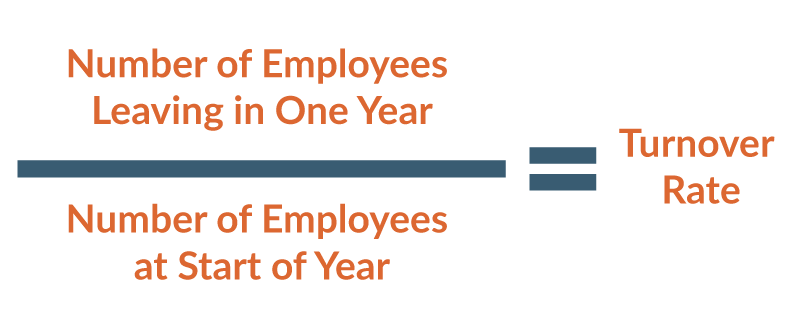
The turnover rate can be calculated for an organization, department, position, or individual employee. The calculation is the same in all cases. It is vital to understand why people leave departments.
Organizations should aim for 10% or less for an employee turnover rate, but most fall into the range of 12% to 20%. Some industries have higher turnover rates due to the nature of the job.
For example, the call center industry is known to have a high turnover rate due to the nature of repeated job transitions and low pay compared with other jobs available in the economy.
Industries such as retail and food service industries often experience the highest turnover rates, ranging from 50% to 100%, with an average of 80%.
Retail businesses need a high turnover rate because positions become available frequently. These industries require a large number of employees for any given store location at particular times of the year.
Employee turnover rate formula
The employee turnover rate is the number of employees who departed during the time period divided by the average number of employees during that time period, multiplied by 100.
To calculate the employee turnover rate for any particular time period, you need:
- The number of employees on the first day
- The number of employees on the last day, and
- The number of separations.
Add the first two numbers together, and divide by two. Then divide the number of separations by that number. Finally, multiply that quotient by 100. That is your turnover rate.
Just as employee turnover is a factor in the success of your overall business, the percentage of employees who quit during a given time frame is also a critical employee retention statistic. By measuring employee turnover rates over time, you can pinpoint exactly where both issues occur within your organization.
You will be able to identify problems quickly to take steps to improve your employee retention efforts.
The employee turnover rate is a significant number to monitor regarding employee retention. It’s vital that you hire, train and motivate your employees in such a way that they’re happy in their jobs and want to stay with the company for years to come.
The only way to keep track of the number of people leaving is to use the employee turnover rate formula continuously.
Average employee turnover rates by industry
Turnover rates vary by industry. The turnover rates listed below may surprise you.
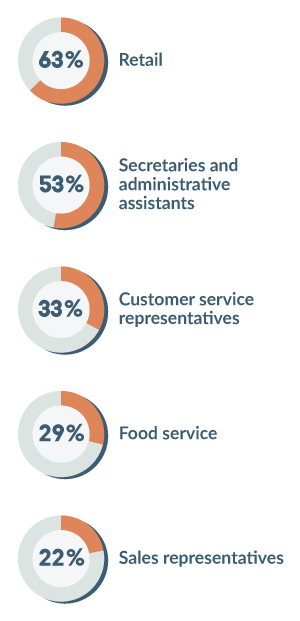
Retail: 63%
The retail industry has a high turnover rate among its staff. The tough work culture and low wages are not very attractive to young workers, especially when other sectors like telecom offer much better prospects for career growth.
Secretaries and administrative assistants: 53%
Secretaries and administrative assistants have high turnover rates, so finding a good assistant is not always easy. Knowing what to look for in a secretary or administrative assistant can help you find the perfect person to fit into your office environment and carry out your requests, as well as a person who can perform many other tasks.
Another thing that managers fail to look into is the high demand for work put on some secretaries and administrative assistants. Their jobs can be very demanding, and in many cases, their pay doesn’t measure up, so they are on the lookout for a better position with better pay and benefits.
Customer service representatives: 33%
Customer service is one of the most demanding jobs for the money, which is why it has a high employee turnover rate. It is also important to note that several companies have customer service reps working from home, even if they’re call center companies. They can be paying as low as $2,000 a month.
Food service: 29%
The food service industry has a high employee turnover rate because it is a service industry, and unfortunately, personalities come in all shapes and forms. It’s near impossible to keep employees working in the food-service sector for an extended period of time.
There’s no real way to ensure that employees will maintain a respectful attitude toward their customers while on duty. And with this lack of control over your employees comes the issue of employee turnover and satisfaction as well as customer satisfaction.
Sales representatives: 22%
Sales centers have a high employee turnover because most people don’t want to work in a call center environment. And it’s not necessarily because they hate the products or company, but because there is a lack of personal fulfillment and in most cases a huge set of rules to follow.
More industries
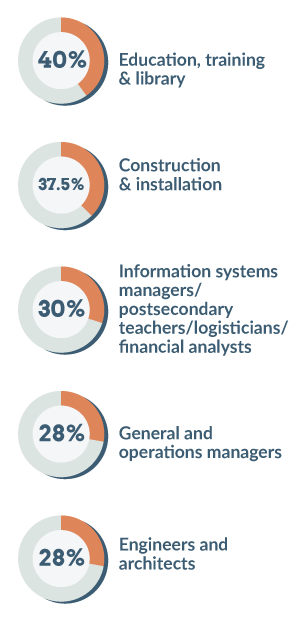
Here are more employee turnover rates by industry:
- Education, training & library: 40%
- Construction & installation: 37.5%
- Information systems managers/postsecondary teachers/logisticians/financial analysts: 30%
- General and operations managers: 28%, and
- Engineers and architects: 28%.
The point of providing these statistics is to give an idea of which industries struggle the most with turnover and why. No one wants to work where they have nothing in common with the other employees and where ideas are frowned upon by senior management.
Nor do they want to work where they are regarded as exposable. Individuals want to feel that their strengths add value to the company they choose to work for. It’s simple, really: Workers who feel undervalued will look for better opportunities.
How did the pandemic affect turnover rates?
Employee turnover rates in any organization usually result from employee dissatisfaction. In a pandemic, employees are more concerned about the health and safety of their families. In this case, employee turnover can result in employee retention as employees may want to work for an employer who will give them the flexibility they need.
One of the biggest reasons people quit their jobs is because they feel underpaid compared to industry standards. Many workers would be willing to stay put if their company was willing to increase their pay and understand that life happens to them just as it happens to their management team.
Leaders would improve employee retention rates at their company if they treated their workers as part of their team and not as another cog in the machine.
Are industries seeing more voluntary or involuntary turnover during the pandemic?
The employee turnover rate in many industries can be influenced by how employees leave their jobs. Employees in some industries may feel more comfortable quitting their jobs than others, resulting in a higher voluntary turnover rate.
The employee turnover rate in these types of environments is often much lower than the employee turnover rates in other industries where it’s not encouraged or allowed for workers to quit so easily.
Professional-level positions such as management and executives will typically have an employee turnover rate similar to those found in most service industry jobs. Why? These professionals often aren’t able to find the same level of work when they’re let go from their former employer, so they don’t even bother looking for new opportunities.
The pandemic may be a good reason to want to leave a company to be safer and avoid the COVID-19 virus. But the question that comes back without an answer is, “Can I afford it?”
While many companies are attempting to do things to help workers feel safe, it may not be enough to prevent the transmission of the virus and keep them and their families safe.
Wrapping up
This article is an attempt to look at the issue through the lens of data to uncover patterns in employee retention and identify strategies for creating happier tech workplaces.
If you are looking for information to help your business reduce high employee turnover, check out our Turnover Toolkit. It will give you everything you need to increase positive engagement and employee retention. Make employee turnover a thing of the past. Increase productivity, business efficacy, and revenue with the help of this toolkit.
